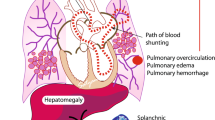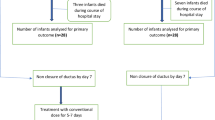Abstract
A patent ductus arteriosus (PDA) in infants born premature can present significant management challenges for neonatal providers. Quantifying a hemodynamically significant PDA (hsPDA) represents the first hurdle, however, identifying the best evidence-based approach amongst conservative, pharmacologic, and/or interventional management options has proven to be even more complicated. Within the conservative arm, furosemide to reduce pulmonary edema and improve lung function has spawned several discussions given the concerns for its upregulation of prostaglandin E2 in the kidneys and conflicting outcomes data. There remains no consensus regarding furosemide use in hsPDAs. In this perspective article, we summarize the approach to defining a hsPDA, review the current practice of furosemide use in the management of hsPDA, and suggest an approach to fluid management and diuresis to address the question: is the routine use of furosemide in hsPDA merited in current practice?
This is a preview of subscription content, access via your institution
Access options
Subscribe to this journal
Receive 12 print issues and online access
$259.00 per year
only $21.58 per issue
Buy this article
- Purchase on Springer Link
- Instant access to full article PDF
Prices may be subject to local taxes which are calculated during checkout

Similar content being viewed by others
References
Hamrick SEG, Sallmon H, Rose AT, Porras D, Shelton EL, Reese J, et al. Patent ductus arteriosus of the preterm infant. Pediatrics. 2020;146:1–15.
Hundscheid T, El-Khuffash A, McNamara PJ, de Boode WP. Survey highlighting the lack of consensus on diagnosis and treatment of patent ductus arteriosus in prematurity. Eur J Pediatr. 2022;181:2459–68.
Prescott S, Keim-Malpass J. Patent ductus arteriosus in the preterm infant: diagnostic and treatment options. Adv Neonatal Care. 2017;17:10–18.
de Klerk JCA, Engbers AGJ, van Beek F, Flint RB, Reiss IKM, Völler S, et al. Spontaneous closure of the ductus arteriosus in preterm infants: a systematic review. Front Pediatr. 2020;8:541.
Smith A, McNamara PJ, El-Khuffash AF. Non-pharmacological management of a hemodynamically significant patent ductus arteriosus. Semin Fetal Neonatal Med. 2018;23:245–9.
El-Khuffash A, Levy PT, Gorenflo M, Frantz ID 3rd. The definition of a hemodynamically significant ductus arteriosus. Pediatr Res. 2019;85:740–1.
Smith A, El-Khuffash AF. Defining “haemodynamic significance” of the patent ductus arteriosus: do we have all the answers? Neonatology. 2020;117:225–32.
Hundscheid T, Jansen EJS, Onland W, Kooi EMW, Andriessen P, de Boode WP. Conservative management of patent ductus arteriosus in preterm infants-a systematic review and meta-analyses assessing differences in outcome measures between randomized controlled trials and cohort studies. Front Pediatr. 2021;9:626261.
Altit G, Saeed S, Beltempo M, Claveau M, Lapointe A, Basso O. Outcomes of extremely premature infants comparing patent ductus arteriosus management approaches. J Pediatr. 2021;235:49–57.e42.
Semberova J, Sirc J, Miletin J, Kucera J, Berka I, Sebkova S, et al. Spontaneous closure of patent ductus arteriosus in infants ≤1500 g. Pediatrics. 2017;140:1–8.
de Carvalho Nunes G, Wutthigate P, Simoneau J, Beltempo M, Sant’Anna GM, Altit G. Natural evolution of the patent ductus arteriosus in the extremely premature newborn and respiratory outcomes. J Perinatol. 2022;42:642–8.
Green TP, Thompson TR, Johnson D, Lock JE. Furosemide use in premature infants and appearance of patent ductus arteriosus. Am J Dis Child. 1981;135:239–43.
Green TP, Johnson DE, Bass JL, Landrum BG, Ferrara TB, Thompson TR. Prophylactic furosemide in severe respiratory distress syndrome: blinded prospective study. J Pediatr. 1988;112:605–12.
Green TP, Thompson TR, Johnson DE, Lock JE. Furosemide promotes patent ductus arteriosus in premature infants with the respiratory-distress syndrome. N Engl J Med. 1983;308:743–8.
Stephens BE, Gargus RA, Walden RV, Mance M, Nye J, McKinley L, et al. Fluid regimens in the first week of life may increase risk of patent ductus arteriosus in extremely low birth weight infants. J Perinatol. 2008;28:123–8.
Bell EF, Acarregui MJ. Restricted versus liberal water intake for preventing morbidity and mortality in preterm infants. Cochrane Database Syst Rev. 2014;2014:Cd000503.
De Buyst J, Rakza T, Pennaforte T, Johansson AB, Storme L. Hemodynamic effects of fluid restriction in preterm infants with significant patent ductus arteriosus. J Pediatr. 2012;161:404–8.
Hansson L, Lind T, Wiklund U, Öhlund I, Rydberg A. Fluid restriction negatively affects energy intake and growth in very low birthweight infants with haemodynamically significant patent ductus arteriosus. Acta Paediatr. 2019;108:1985–92.
<Management of the patent ductus arteriosus in preterm infants_Canadian Paediatric Society.pdf>.
Iacobelli S, Lorrain S, Gouyon B, Gambacorta S, Laforgia N, Gouyon JB, et al. Drug exposure for PDA closure in France: a prospective, cohort-based, analysis. Eur J Clin Pharm. 2020;76:1765–72.
Pacifici GM. Clinical pharmacology of furosemide in neonates: a review. Pharmacology. 2013;6:1094–129.
Sulyok E, Varga F, Németh M, Tényi I, Csaba IF, Ertl T, et al. Furosemide-induced alterations in the electrolyte status, the function of renin-angiotensin-aldosterone system, and the urinary excretion of prostaglandins in newborn infants. Pediatr Res. 1980;14:765–8.
Mann B, Hartner A, Jensen BL, Kammerl M, Krämer BK, Kurtz A. Furosemide stimulates macula densa cyclooxygenase-2 expression in rats. Kidney Int. 2001;59:62–68.
Crossley KJ, Allison BJ, Polglase GR, Morley CJ, Davis PG, Hooper SB. Dynamic changes in the direction of blood flow through the ductus arteriosus at birth. J Physiol. 2009;587(Pt 19):4695–704.
Miyanoshita A, Terada M, Endou H. Furosemide directly stimulates prostaglandin E2 production in the thick ascending limb of Henle’s loop. J Pharm Exp Ther. 1989;251:1155–9.
Toyoshima K, Momma K, Nakanishi T. In vivo dilatation of the ductus arteriosus induced by furosemide in the rat. Pediatr Res. 2010;67:173–6.
Olsen UB, Ahnfelt-Ronne I. Bumetanide induced increase of renal blood flow in conscious dogs and its relation to local renal hormones (PGE, kallikrein and renin). Acta Pharm Toxicol. 1976;38:219–28.
Kaufman J, Hamburger R, Matheson J, Flamenbaum W. Bumetanide-induced diuresis and natriuresis: effect of prostaglandin synthetase inhibition. J Clin Pharm. 1981;21:663–7.
Ellison DH. Clinical pharmacology in diuretic use. Clin J Am Soc Nephrol. 2019;14:1248–57.
Mirochnick MH, Miceli JJ, Kramer PA, Chapron DJ, Raye JR. Furosemide pharmacokinetics in very low birth weight infants. J Pediatr. 1988;112:653–7.
Tuck S, Morselli P, Broquaire M, Vert P. Plasma and urinary kinetics of furosemide in newborn infants. J Pediatr. 1983;103:481–5.
Vert P, Broquaire M, Legagneur M, Morselli PL. Pharmacokinetics of furosemide in neonates. Eur J Clin Pharm. 1982;22:39–45.
Peterson RG, Simmons MA, Rumack BH, Levine RL, Brooks JG. Pharmacology of furosemide in the premature newborn infant. J Pediatr. 1980;97:139–43.
Aranda JV, Perez J, Sitar DS, Collinage J, Portuguez-Malavasi A, Duffy B, et al. Pharmacokinetic disposition and protein binding of furosemide in newborn infants. J Pediatr. 1978;93:507–11.
Reyes JL, Aldana I, Barbier O, Parrales AA, Melendez E. Indomethacin decreases furosemide-induced natriuresis and diuresis on the neonatal kidney. Pediatr Nephrol. 2006;21:1690–7.
Guignard JP, Dubourg L, Gouyon JB. Diuretics in the neonatal period. Rev Med Suisse Romand. 1995;115:583–90.
Laughon MM, Chantala K, Aliaga S, Herring AH, Hornik CP, Hughes R, et al. Diuretic exposure in premature infants from 1997 to 2011. Am J Perinatol. 2015;32:49–56.
Ding D, Liu H, Qi W, Jiang H, Li Y, Wu X, et al. Ototoxic effects and mechanisms of loop diuretics. J Otol. 2016;11:145–56.
Jackson W, Taylor G, Selewski D, Smith PB, Tolleson-Rinehart S, Laughon MM. Association between furosemide in premature infants and sensorineural hearing loss and nephrocalcinosis: a systematic review. Matern Health Neonatol Perinatol. 2018;4:23.
Saarela T, Lanning P, Koivisto M, Paavilainen T. Nephrocalcinosis in full-term infants receiving furosemide treatment for congestive heart failure: a study of the incidence and 2-year follow up. Eur J Pediatr. 1999;158:668–72.
Andriessen P, Struis NC, Niemarkt H, Oetomo SB, Tanke RB, Van Overmeire B. Furosemide in preterm infants treated with indomethacin for patent ductus arteriosus. Acta Paediatr. 2009;98:797–803.
Lasix (furosemide) tablets label - Accessdata.fda.gov https://www.accessdata.fda.gov
Belik J, Spitzer AR, Clark BJ, Gewitz MH, Fox WW. Effect of early furosemide administration in neonates with respiratory distress syndrome. Pediatr Pulmonol. 1987;3:219–25.
Yeh TF, Wilks A, Singh J, Betkerur M, Lilien L, Pildes RS. Furosemide prevents the renal side effects of indomethacin therapy in premature infants with patent ductus arteriosus. J Pediatr. 1982;101:433–7.
Romagnoli C, Zecca E, Papacci P, De Carolis MP, Giannini R, Gallini F, et al. Furosemide does not prevent indomethacin-induced renal side effects in preterm infants. Clin Pharm Ther. 1997;62:181–6.
Lee BS, Byun SY, Chung ML, Chang JY, Kim HY, Kim EA, et al. Effect of furosemide on ductal closure and renal function in indomethacin-treated preterm infants during the early neonatal period. Neonatology. 2010;98:191–9.
Thompson EJ, Greenberg RG, Kumar K, Laughon M, Smith PB, Clark RH, et al. Association between furosemide exposure and patent ductus arteriosus in hospitalized infants of very low birth weight. J Pediatr. 2018;199:231–6.
Ciociola EC, Kumar KR, Zimmerman KO, Thompson EJ, Harward M, Sullivan LN, et al. Association between preoperative respiratory support and outcomes in paediatric cardiac surgery. Cardiol Young. 2020;30:66–73.
North West, North Wales, Isle of Man Children’s Heart. Guideline for the management of patent ductus arteriosus (PDA). 2020 https://www.northwestchdnetwork.nhs.uk/wp-content/uploads/2021/05/GL-ODN-09-NW-Guideline-for-the-Management-of-PDA-Revised.pdf
Laragh JH. The mode of action and use of chlorothiazide and related compounds. Circulation. 1962;26:121–32.
Author information
Authors and Affiliations
Contributions
SD, SS, AEK, and PL conceptualized the study, shared equal writing responsibilities, edited, and approved the submission.
Corresponding author
Ethics declarations
Competing interests
The authors declare no competing interests.
Additional information
Publisher’s note Springer Nature remains neutral with regard to jurisdictional claims in published maps and institutional affiliations.
Rights and permissions
About this article
Cite this article
Dudley, S., Sen, S., Hanson, A. et al. The role of furosemide and fluid management for a hemodynamically significant patent ductus arteriosus in premature infants. J Perinatol 42, 1703–1707 (2022). https://doi.org/10.1038/s41372-022-01450-1
Received:
Revised:
Accepted:
Published:
Issue Date:
DOI: https://doi.org/10.1038/s41372-022-01450-1



